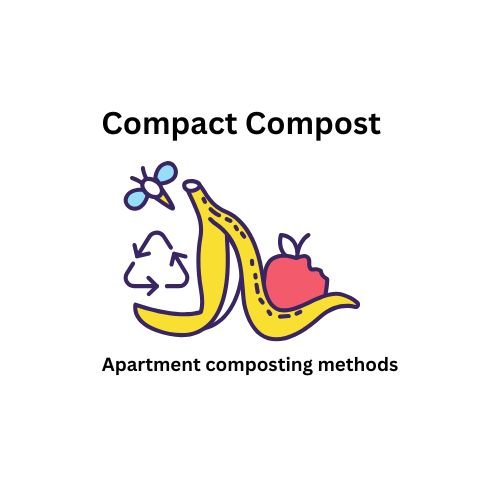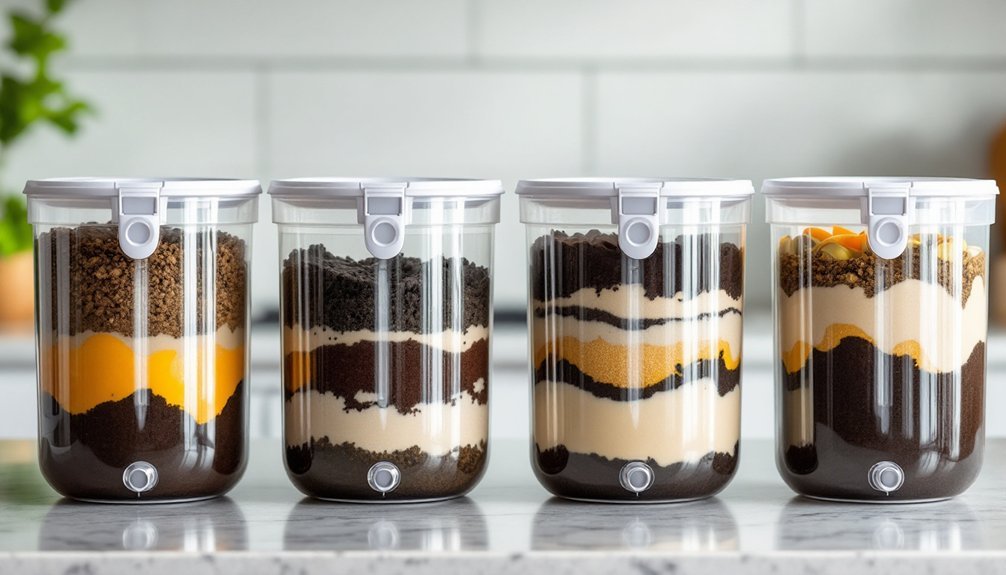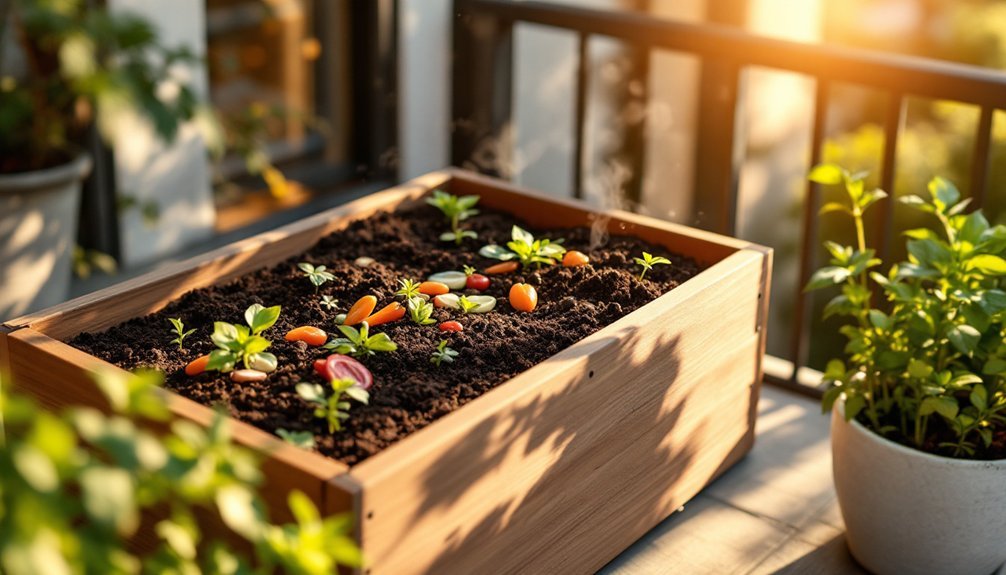You'll find that choosing the right compost thermometer can make or break your indoor composting success. While basic models might give you a rough temperature reading, today's advanced options offer everything from wireless monitoring to detailed data tracking right on your smartphone. Whether you're a beginner or a seasoned composter, understanding the key differences between these top seven thermometers will help you maintain ideal decomposition conditions and avoid common composting pitfalls.
HT1 Wireless Digital Thermometer/Hygrometer for Smart Devices
For tech-savvy gardeners who want precise temperature monitoring at their fingertips, the HT1 Wireless Digital Thermometer offers seamless smartphone integration and versatile tracking capabilities.
You'll appreciate its compact 1.57-inch design and impressive 100-meter Bluetooth range. The device logs 20 days of data directly on-board while providing unlimited storage through its user-friendly app. With a battery life of up to 2 years, you won't need frequent replacements. The sensor effectively monitors temperature, humidity, dew point, and VPD – vital metrics for successful composting. While it lacks direct smart home integration, its reliable performance and responsive U.S.-based customer support make it a solid choice.
Best For: Tech-savvy home gardeners, greenhouse operators, and DIY enthusiasts who need precise environmental monitoring with smartphone connectivity and detailed data logging capabilities.
Pros:
- Long battery life (1-2 years) with easy setup and user-friendly smartphone app integration
- Impressive 100-meter Bluetooth range with 20 days of on-board data storage
- Reliable accuracy for temperature, humidity, dew point, and VPD measurements
Cons:
- Lacks direct integration with popular smart home platforms like Alexa or Google Home
- Requires additional G1 WiFi Gateway purchase for remote access beyond Bluetooth range
- Made in China, which may concern some users regarding quality and durability
Long Stem Compost Soil Thermometer with Protective Sheath
A robust 16-inch stainless steel stem makes this thermometer ideal for serious composters who need deep, accurate readings from their piles. The 304-grade stainless steel construction guarantees durability, while the hermetically-sealed glass prevents fogging during use.
You'll appreciate the 1.9" dial that's easy to read, displaying both Celsius and Fahrenheit measurements across three temperature zones. The included protective sheath extends the thermometer's life and makes storage simple. As a bonus, you'll get a composting guide with tips to help optimize your pile's performance. With quick response times and reliable accuracy, you can effectively monitor your compost's progress throughout the decomposition process.
Best For: Serious composters and gardeners who need accurate temperature readings from deep within their compost piles or soil beds.
Pros:
- Long 16-inch stainless steel stem allows for deep temperature measurements
- Hermetically-sealed, fog-free glass with easy-to-read 1.9" dial showing both Celsius and Fahrenheit
- Includes protective sheath and composting guide for enhanced durability and usage
Cons:
- May be unnecessarily long for small garden beds or containers
- Requires careful handling and storage to maintain accuracy
- Premium construction materials may make it more expensive than basic soil thermometers
Fishnure 20" Compost Thermometer for Indoor & Outdoor Use
Serious composters will appreciate the Fishnure 20" Compost Thermometer's robust design and precise temperature monitoring capabilities. The stainless steel construction features a pitted tip that easily penetrates hard-packed compost, while its weather-resistant build guarantees durability in outdoor conditions.
You'll find the 20-inch probe length ideal for reaching deep into your pile to measure core temperatures. The 1.8" diameter dial displays clear Celsius readings across three zones: Warm (26-37°C), Ideal (38-54°C), and Hot (55-71°C). While some users wish for a Fahrenheit scale, the Celsius measurements remain accurate enough for effective compost monitoring and pile management.
Best For: Dedicated composters and homesteaders who need accurate temperature monitoring of large compost piles and want a durable, weather-resistant thermometer for regular use.
Pros:
- Long 20-inch probe with pitted steel tip effectively reaches core temperatures in large compost piles
- Sturdy stainless steel construction and weather-resistant design ensures long-term durability
- Clear temperature zone readings help identify optimal composting conditions
Cons:
- Only displays Celsius temperature readings, requiring conversion for Fahrenheit users
- Some units reported issues with detached needles upon arrival
- Relatively large 1.8" diameter dial may be cumbersome for smaller composting setups
Geevon Digital Thermometer and Hygrometer with Remote Sensor
Gardeners needing a multi-purpose monitoring solution will find the Geevon Digital Thermometer and Hygrometer ideal for both compost and general outdoor temperature tracking. You'll appreciate its large, easy-to-read display and 3-channel monitoring capability that lets you track multiple compost piles or garden zones simultaneously.
The device offers impressive versatility with its 200ft wireless range and dual power options – battery or USB. You can monitor essential data like temperature, humidity, and even mold risk indices. While it's not specifically designed for compost, its weather-resistant construction and reliable performance make it a practical choice for basic composting needs, especially when you want to track both indoor and outdoor conditions.
Best For: Home gardeners and composting enthusiasts who need to monitor multiple outdoor locations and want an easy-to-read display with basic weather tracking capabilities.
Pros:
- Large, clear display with automatic light sensing makes readings easily visible for all users
- Versatile 3-channel monitoring system allows tracking of multiple locations up to 200ft away
- Dual power options (battery or USB) and durable construction ensure reliable continuous operation
Cons:
- Weather forecast feature has limited accuracy (40-45% success rate)
- Outdoor sensor may take time to stabilize and display accurate readings
- Not specifically designed for compost monitoring, though it can be adapted for this use
Digital Indoor Outdoor Thermometer with Wireless Sensor
Monitoring multiple compost piles simultaneously becomes effortless with the U UNNI Digital Indoor Outdoor Thermometer's wireless capabilities. You'll get real-time updates every 30 seconds from three sensors that transmit data up to 330 feet away, even through walls.
The thermometer's wide temperature range (-40°F to +158°F) and ±1.8°F accuracy make it ideal for tracking your compost's temperature zones. The 4.5-inch LCD display features adjustable backlight settings and shows MAX/MIN records that reset daily. You can power it via USB or batteries, and it's compatible with rtl_433 for data logging. The sensors' proven durability and two-year battery life guarantee reliable long-term monitoring of your composting operation.
Best For: Composting enthusiasts and gardeners who need to monitor multiple compost piles with precise temperature tracking and real-time updates.
Pros:
- Excellent wireless range of 330 feet with ability to monitor three locations simultaneously
- Wide temperature range (-40°F to +158°F) with good accuracy (±1.8°F) ideal for compost monitoring
- Long battery life and proven durability make it reliable for extended outdoor use
Cons:
- Display brightness and viewing angles may be problematic in certain lighting conditions
- No power adapter included with USB cable
- Daily reset of MAX/MIN records cannot be disabled for longer-term tracking
Govee H5075 Bluetooth Indoor Hygrometer Thermometer
The Govee H5075 Bluetooth Indoor Hygrometer Thermometer combines versatility with high-tech features, making it a smart choice for tech-savvy composters who want detailed data tracking.
You'll appreciate the ±0.54°F temperature accuracy and rapid 2-second refresh rate when monitoring your compost conditions. The device's 3-inch LCD screen displays clear readings, while the Govee app provides extensive data analysis through 20-day curve graphs. You can export data in CSV format and store historical information for up to two years.
The included batteries and straightforward setup let you start monitoring quickly, though you'll need to secure it properly if using it outdoors. The reliable alerts notify you when temperatures fall outside your preset ranges.
Best For: Home composters and gardeners who want detailed temperature and humidity tracking with smartphone connectivity and historical data analysis.
Pros:
- High accuracy (±0.54°F) with fast 2-second refresh rate provides reliable temperature and humidity monitoring
- Comprehensive data management with 2-year storage and exportable CSV format for detailed analysis
- User-friendly setup with clear LCD display and customizable alerts through the Govee app
Cons:
- Bluetooth connectivity can be inconsistent, potentially affecting remote monitoring capabilities
- Not specifically designed for outdoor use, requiring additional protection for weather exposure
- Limited to Bluetooth range for data transmission, lacking WiFi connectivity options
Reotemp Backyard Compost Thermometer (20 Inch)
Serious composters seeking professional-grade accuracy will appreciate the Reotemp Backyard Compost Thermometer's robust construction and 20-inch stainless steel probe. You'll find the large, easy-to-read dial displays clear Fahrenheit readings across three temperature zones, helping you monitor your pile's activity.
The thermometer's hermetically sealed design prevents fogging, while its pointed tip guarantees smooth insertion into deep compost. You'll also receive a free digital composting guide with expert tips. While it's not waterproof and requires careful storage, the durability and precision make it a worthy investment. Just remember to avoid hitting hard objects with the probe and store it in a dry place between uses.
Best For: Dedicated home composters and gardeners who need accurate temperature monitoring of large or deep compost piles and want professional-grade equipment.
Pros:
- Long 20-inch stainless steel probe reaches deep into compost piles
- Clear, easy-to-read dial with helpful temperature zone indicators
- Includes comprehensive digital composting guide with expert tips
Cons:
- Not waterproof and requires storage in dry conditions
- Takes several minutes to provide accurate temperature readings
- Risk of damage if probe hits hard objects in compost pile
Factors to Consider When Choosing Compost Thermometers for Monitoring Indoor Systems
When selecting a thermometer for your indoor composting system, you'll need to contemplate both the physical characteristics and performance features that match your setup. Your indoor composter requires a shorter probe length and compact design compared to outdoor units, while the choice between digital and analog displays affects readability in low-light conditions. Temperature range, response speed, and resistance to indoor humidity will impact your ability to maintain ideal decomposition conditions and prevent moisture damage to the instrument.
Length and Probe Design
Selecting appropriate probe length and design features stands vital for effective indoor compost monitoring. While you'll find thermometers ranging from 12 to 24 inches, your indoor composting system's size should dictate the ideal length. You'll want a probe that reaches the pile's core without being unnecessarily long for your setup.
Look for stainless steel construction with a pointed tip, as this combination guarantees durability and easy penetration into your compost materials. A hermetically sealed design prevents fogging, which you'll appreciate when checking readings in humid indoor environments. Don't overlook dial size – a wider display of at least 1.9 inches makes temperature readings quick and clear. Confirm your thermometer's range covers all significant composting zones, from warm (26-37°C) through hot (55-71°C) temperatures.
Digital Vs Analog Display
Beyond probe design, your choice between digital and analog displays shapes how you'll interact with your compost thermometer. Digital displays offer quick readings, enhanced visibility, and useful features like data logging and temperature alerts. You'll appreciate their backlit screens in low-light conditions and precise temperature tracking capabilities.
Analog displays, while simpler to operate, require manual reading and can be harder to interpret from a distance. However, you won't need to worry about batteries or electronic failures with an analog model. If you're monitoring your compost in areas without reliable power sources, analog thermometers prove more dependable. They're also typically more durable in challenging outdoor conditions. Consider your specific needs – if detailed data tracking is essential, go digital. If reliability and simplicity are priorities, an analog display might serve you better.
Temperature Reading Range
The essential temperature reading range for an indoor compost thermometer should span from 0°C to 100°C (32°F to 212°F) to capture all phases of the composting process. This thorough range guarantees you'll monitor both cool-down periods and peak heating activities effectively.
Your thermometer must accurately measure three critical temperature zones: warm (26-37°C), ideal (38-54°C), and hot (55-71°C). These distinct ranges help you track your compost's progression and make necessary adjustments to maintain ideal decomposition. Look for models that display both Celsius and Fahrenheit readings, as you won't need to perform manual conversions. Since indoor composting systems can vary in depth, choose a thermometer with a probe length that'll reach the center of your specific setup to get accurate core temperature readings.
Response Time Capabilities
When monitoring indoor compost systems, rapid response time capabilities play an essential role in maintaining ideal conditions. You'll want to select a thermometer that provides quick, accurate readings to help you make timely adjustments to your compost pile.
While some thermometers give you readings within seconds, others might take several minutes to stabilize. For indoor composting, you'll benefit from faster response times since they allow you to quickly check multiple spots in your bin and respond promptly to temperature changes. Consider the probe length when selecting your thermometer – longer probes typically take more time to register core temperatures.
Choose a thermometer that balances speed with accuracy. You don't want to sacrifice precise measurements for quick readings, as both factors are vital for successful indoor composting.
Durability in Humid Conditions
Indoor composting environments naturally generate high humidity levels, which can pose significant challenges for monitoring equipment. You'll want to choose a compost thermometer with a hermetically-sealed design to prevent fog from obscuring the dial and compromising your readings.
Look for thermometers made from stainless steel, as they'll resist corrosion and stand up to constant moisture exposure. When selecting your device, make certain it features waterproof or water-resistant construction to protect its internal components. You'll also benefit from a protective storage case or sheath, which shields your thermometer from humidity when it's not in use.
To maintain your thermometer's performance in humid conditions, make it a habit to dry it thoroughly after each use. This simple maintenance step will help preserve accuracy and extend your device's lifespan.
Power Source Options
Selecting the right power source for your compost thermometer can greatly impact its reliability and convenience during long-term monitoring. You'll find two main options available: battery-powered and USB-powered models.
Battery-operated thermometers offer excellent portability, letting you move freely around your composting space. However, you'll need to plan for regular battery replacements, which vary by model and usage frequency. If you're operating in cold conditions, consider units that use lithium batteries, as they perform better than alkaline alternatives.
For indoor setups, dual-powered thermometers provide the best flexibility. You can use USB power for continuous monitoring while keeping batteries as a backup. When choosing your thermometer, consider where you'll place it and whether you'll need constant access to an electrical outlet.
Data Logging Features
A robust data logging system serves as the backbone of effective compost monitoring. You'll find models that can store temperature readings anywhere from 20 days to 2 years, giving you thorough insight into your composting process.
When selecting your thermometer, look for devices that export data in CSV format, making it easier to analyze trends and adjust your composting strategy. You'll want to track temperature fluctuations to determine ideal times for turning your pile and maintaining the right carbon-to-nitrogen balance. Some advanced thermometers offer visual representations through graphs, helping you quickly spot patterns in temperature and humidity changes. These features let you make data-driven decisions about your compost management, ultimately leading to more successful indoor composting results.
Installation and Placement Requirements
Proper installation and placement of your compost thermometer can make or break its effectiveness in monitoring indoor systems. You'll need to insert the probe vertically into your pile's center, guaranteeing the 16-20 inch length reaches deep enough to capture accurate core temperatures.
When installing your thermometer, check that it's hermetically sealed to prevent moisture-related issues like fogging, which can affect readings. Position the device in areas with good airflow to avoid heat pockets and achieve even temperature distribution throughout your compost. After turning your pile, don't forget to reposition the thermometer correctly.
For consistent monitoring, you'll want to maintain proper placement throughout the composting process. Regular checks guarantee your thermometer continues to provide reliable data from the most representative areas of your indoor system.
Frequently Asked Questions
How Often Should I Clean My Compost Thermometer?
You'll want to clean your compost thermometer after each use to prevent cross-contamination. Simply wipe it down with soapy water and dry thoroughly. For deeper cleaning, sanitize it monthly with rubbing alcohol.
Can Indoor Compost Thermometers Be Used in Worm Bins?
Yes, you can use compost thermometers in worm bins, but you'll want to check temperatures gently to avoid disturbing your worms. Keep in mind that worm bins should stay between 55-77°F for ideal conditions.
What Temperature Indicates My Compost Has Gone Anaerobic?
If your compost temperature rises above 160°F (71°C), it's likely gone anaerobic. You'll also notice unpleasant sour or rotten egg smells. Turn the pile immediately to reintroduce oxygen and lower the temperature.
How Deep Should I Insert the Thermometer Probe for Accurate Readings?
You'll want to insert your thermometer probe into the center of your compost pile, about 12-18 inches deep. If you've got a smaller bin, aim for the middle depth to get the most accurate temperature reading.
Why Do Temperature Readings Vary in Different Parts of My Pile?
You'll notice temperature variations because different areas decompose at varying rates. The center's usually hottest, while edges stay cooler. Moisture levels, oxygen flow, and material distribution affect these temperature differences throughout your pile.





Leave a Reply